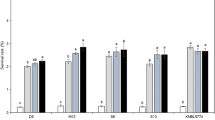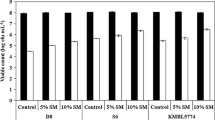Abstract
Effects of treatments with proteolytic enzymes and protein-modifying reagents on flocculation of brewer's yeast IFO 2018 were investigated. The floc-forming ability of the yeast cells was irreversibly eliminated by treatment with papain, trypsin, chymotrypsin or pepsin, indicating that certain proteins on the cell surface participate in the yeast flocculation. Chemical modification with reagents, known to act on disulfide bridges, carboxyl and/or phosphate groups, phenolic groups, amino groups, and imidazole groups, also destroyed the ability to flocculate, although in some cases a high concentration (8 M) of urea was necessary in addition to protein-modifying reagents. Thus, it is suggested strongly that these functional groups of amino acid residues of the proteins are essential for the floc-forming ability of brewer's yeast cells.
Similar content being viewed by others
Abbreviations
- CMA buffer:
-
0.20 M Na-acetate buffer (pH 4.5) containing 0.009 M CaCl2 and 0.004 M MgSO4
- S.P.:
-
sedimentation percentage (see text)
- SH:
-
sulfhydryl
References
Calleja, G. B.: On the nature of the forces involved in the sexdirected flocculation of a fission yeast. Can. J. Microbiol. 20, 797–803 (1974)
Eddy, A. A., Rudin, A. D.: Part of the yeast surface apparently involved in flocculation. J. Inst. Brew. 64, 19–21 (1958)
Fisher, D. J.: Flocculation—some observations on the surface charges of yeast cells. J. Inst. Brew. 81, 107–110 (1975)
Isaieva, V. S., Zhvirblianskaja, A. J., Kritzkova, G. M.: Relation of flocculation to the content of polysaccharides in cell walls of yeast used in continuous brewing process. Kvasny. Prum. 20, 98–100 (1974)
Lyons, T. P., Hough, J. S.: Flocculation of brewer's yeast. J. Inst. Brew. 76, 564–571 (1970)
Lyons, T. P., Hough, J. S.: Further evidence for the cross-bridging hypothesis for flocculation of brewer's yeast. J. Inst. Brew. 77, 300–305 (1971)
Masschelein, C. A., Jeunehomme-Ramos, C., Castiau, C., Devreux, A.: Mechanism of phenotypic variations in the flocculence character of yeast. J. Inst. Brew. 69, 332–337 (1963)
Mill, P. J.: The nature of the interactions between flocculent cells in the flocculation of Saccharomyces cerevisiae. J. gen. Microbiol. 35, 61–68 (1964).
Nielsen, N.: The rate of subsidence of yeast. C. R. Trav. Lab. Carlsberg, Sér. Physiol. 22, 61–86 (1937)
Nishihara, H., Toraya, T., Fukui, S.: Factors affecting flocculation of brewer's yeast. J. Ferment. Technol. 54, 351–355 (1976a)
Nishihara, H., Toraya, T., Fukui, S.: Induction of floc-forming ability in brewer's yeast. J. Ferment. Technol. 54, 356–360 (1976b)
Author information
Authors and Affiliations
Rights and permissions
About this article
Cite this article
Nishihara, H., Toraya, T. & Fukui, S. Effect of chemical modification of cell surface components of a brewer's yeast on the floc-forming ability. Arch. Microbiol. 115, 19–23 (1977). https://doi.org/10.1007/BF00427840
Received:
Issue Date:
DOI: https://doi.org/10.1007/BF00427840




